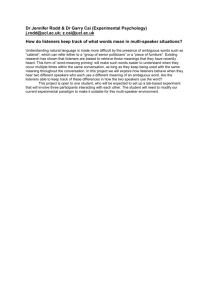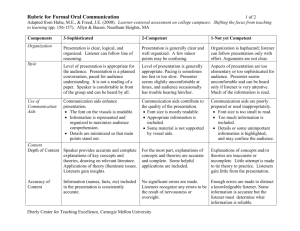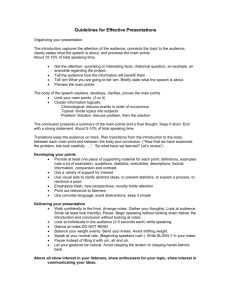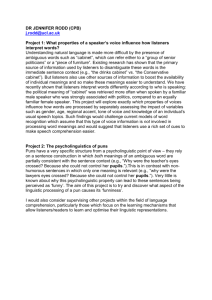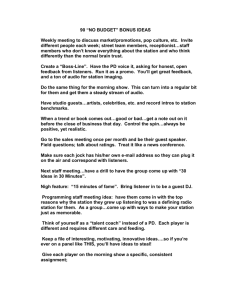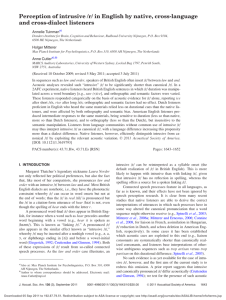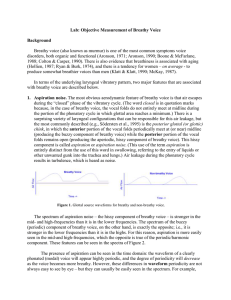Defining and Measuring Voice Quality - ISCA
advertisement
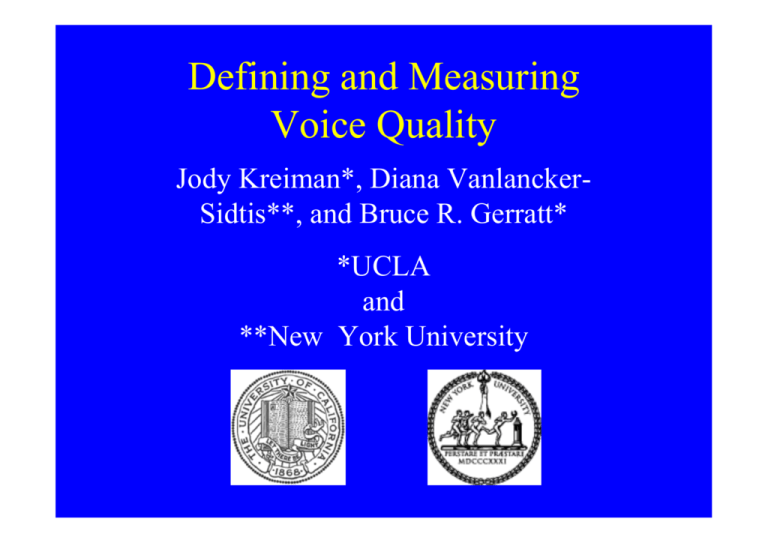
Defining and Measuring Voice Quality Jody Kreiman*, Diana VanlanckerSidtis**, and Bruce R. Gerratt* *UCLA and **New York University Voice Quality is Hard to Measure • Complex • Unstable The Definitional Dilemma • Voice is hard to define • Voice quality is also hard to define The ANSI Definition “…that attribute of auditory sensation in terms of which a listener can judge that two sounds similarly presented and having the same loudness and pitch are dissimilar.” The ANSI Definition • Often maligned – A negative definition – Defines quality in the context of one specific task; hard to operationalize or generalize to other tasks – Implies quality is independent of frequency and amplitude Virtues of the ANSI Definition • Treats sound quality as the result of a perceptual process • Highlights importance of signals and listeners in determining quality Why Include the Listener? • Just as loudness and pitch do not exist without the listener, vocal quality is an acousticPERCEPTUAL phenomenon. How Listeners Introduce Variability • Listeners may pay attention to different acoustic aspects of signals, even in the same task • Importance of a given cue may depend on context or task demands • Different listeners may use different cues • Definitions of quality that focus on production or acoustics cannot account for such effects So: How Should We Measure Quality? • Create lists of terms to describe listeners’ auditory impressions Venerable and Modern Labels for Voice Quality Julius Pollux Clear Deep Brilliant Small, feeble, faint Thin Hollow, indistinct Moore, 1964 Clear, light, white Deep Bright, brilliant Breathy, whispery Thin, pinched, shallow, Hollow, covered Gelfer, 1988 Clear Resonant, low Bright, vibrant Breathy, soft, babyish, weak Thin Muffled More Labels for Voice Quality Julius Pollux Brassy Harsh Shrill, sharp Smooth Dull Moore, 1964 Buzzy, clangy, metallic Harsh, strident, Shrill, sharp, piercing, cutting, pointed Smooth, velvety Dull, heavy, dead Gelfer, 1988 Metallic Harsh, gravelly Shrill, sharp Smooth Dull, heavy, thick Well-known Problems with Rating Scale Approaches • • • • Atheoretical approach Which scales to include? Poor reliability and questionable validity Redundancies and ambiguities – MDS and factor analytic studies have not resolved this problem Vagaries of Scale Definition Breathiness = dry, hard, excited, pointed, cold, choked, rough, cloudy, sharp, poor, bad? (Isshiki et al.) Or: Breathiness = breathy, wheezing, lack of timbre, moments of aphonia, husky, not creaky? (Hammarberg et al.) What to Do? • Voice Profile Analysis – Consistent from phonetic theory – Specifies how scales are related to each other – Specifies where information about quality might be, but does not model listeners’ behavior What to Do? • Acoustic assessment protocols – e.g., Dysphonia severity index, Hoarseness diagram – Depend on inconsistent correlations with perceptual measures for validity as measures of quality What to Do? • Method-of-adjustment task using speech synthesis – Does not depend on selection/definition of labels for quality dimensions – Helps listeners focus attention and avoids reliance on internal standards – Demonstrates causation between acoustic attributes and perceived quality – Follows directly from ANSI definition of quality Strengths/Limitations • Reliability • Directly links perception to acoustics • Technically difficult at present Conclusion • When we cannot measure, our knowledge is meager and unsatisfactory. – Attributed to Lord Kelvin • If it exists, it exists in amounts, and if it exists, it can be measured. – Lord Thorndyke Acknowledgment This research was supported by grant DC01797 from the NIH/NIDCD.

